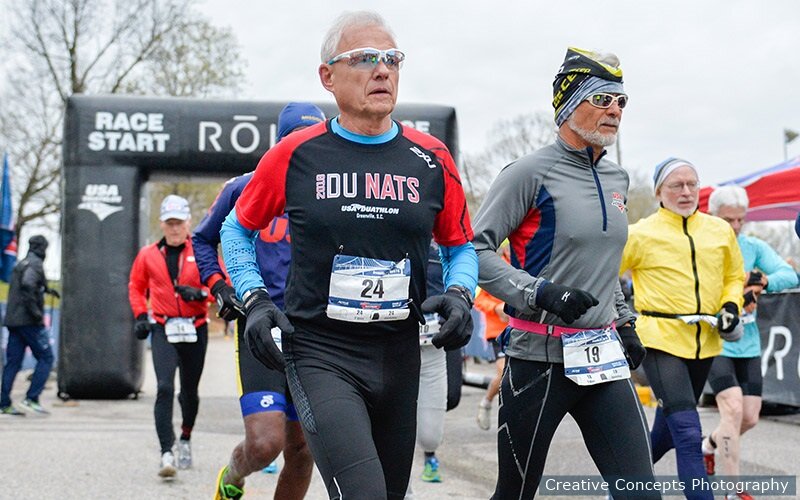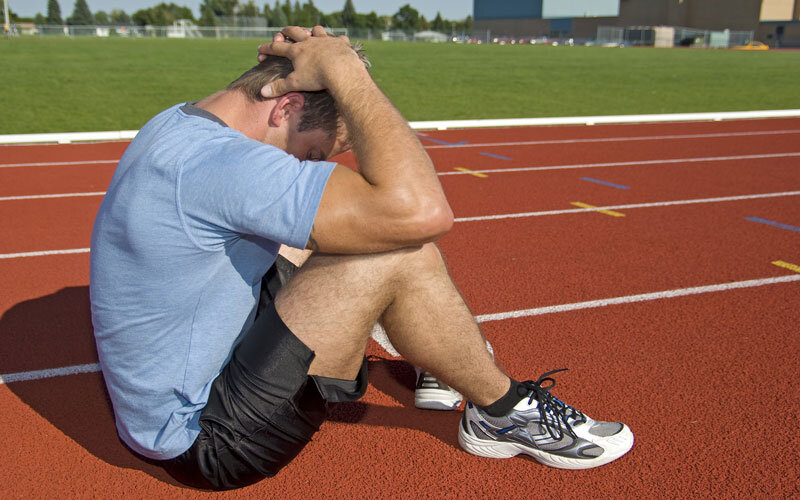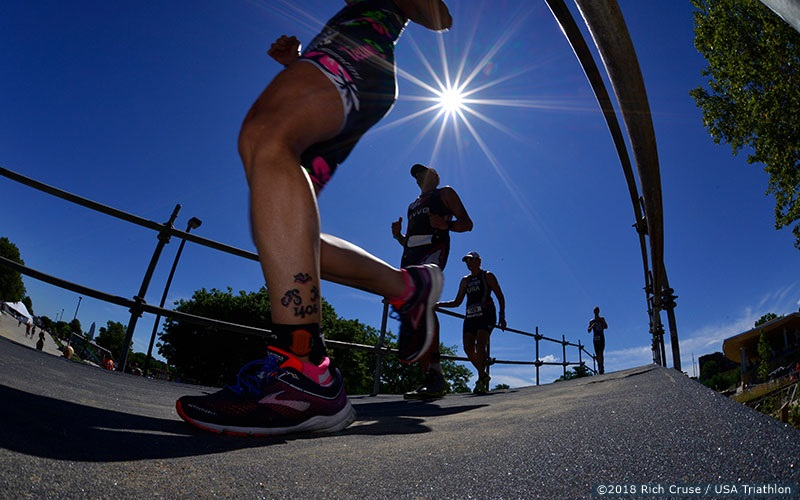USA-Triathlon Website Blog

IT’S BEEN QUITE A RIDE
As the title says, it’s been quite a ride for me in the sport of triathlon. Formerly a non-athlete (except for downhill skiing, which I took up at age 22), I did my first triathlon at the age of 46, on September 17, 1983. For those of you who have been following my writings on the pages of the USA Triathlon Blog (and before that in the original version of the magazine), you know that my career in the sport is winding down. In fact, it may have already wound down completely. Due both to COVID-19 and other factors, I have not raced this year. But I won’t know that for sure about that until next season, when, all else being equal, I plan to give it another whirl. And so, over the course of the next year or so, with the kind permission of my Editor for this space, Tom Lenneberg, I am going to reminisce about 10 of my favorite races, out of the 256 tri’s and du’s that I have done over years.

Ordinary Mortals: Who is a Real Triathlete?
In a recent column in the Spring 2019 issue of USA Triathlon Magazine, our CEO Rocky Harris commented on the new, growing relationship between USA Triathlon and IRONMAN.
Overall, this new relationship is going to be very positive for us and the for the sport. At the same time, we do have to deal with the perception held by some, both inside the sport and outside, that the only “real” triathlon is an IRONMAN.

You Are "Not Dead Yet" and New Book Offers Wellness Wisdom
“Not Dead Yet?” you might ask? Is that any way to title a column on our blog?
Well, yes, that is if it is the title of a new book containing the collected wisdom of a group of 18 world age-group champions in our sports of triathlon and duathlon, all of whom are over 75 years of age. That wisdom, in the form of 56 tips, each with commentary, is provided for (as it is said in the preface to the book): “everyone in mid-life and beyond who wants to be fit and well or, as we say, thriving and flourishing.”

Death and Training and Racing
Last year was not a good one for me. I had the worst tri/du racing season I have ever had since I first started in the sport in 1983. As I recounted in my last two columns of last year (My Lost Season and A Season Recovered), I ended up doing just one of the half-dozen or so races that I had planned for that year.

A Season Recovered
My previous column in this series was entitled “My Lost Season (Almost?),” and in it I described my 2018 season going into September as a “totally lost season, for one reason or another.” I dealt with pre-race sickness twice, a cancelled race, water that was too rough for my seasick tendencies and a family illness preventing travel abroad. Would it end up being totally lost? Well, as I said:

My Lost Season (Almost?)
I’m calling this one my “lost season” — actually my first one ever.
As some of you know, I have been racing triathlons and duathlons since 1983. My first triathlon was on Sept. 17, 1983, at Sag Harbor, N.Y. — the second running of the Mighty Hamptons Triathlon. Since then, by the end of my 35th season last year, I have done a total of 255 triathlons and duathlons.
The USA Triathlon Strategic Plan: How We Can Help
In May 2017, the USA Triathlon Board of Directors issued a Strategic Plan. A year since its original implementation, I decided to take a look at it — especially to see how we, as individual members, might be able to help in its execution.
As an organization, USA Triathlon’s mission is stated “To grow, inspire and support the triathlon community.” Indeed, the organization, the Board and the staff have a major role to play in realizing that mission, but each of us has a role to play as well. Of course, we support the organization with our dues, but also we can do USAT-sponsored races ourselves.

Dealing with Disappointment When Missing a Race
Since last year I had been looking forward to doing the 2018 USA Triathlon Sprint Duathlon Age-Group National Championships (non-drafting), held in Greenville, South Carolina. It was the qualifier for the 2019 International Triathlon Union Age-Group Sprint World Championships in Pontevedra, Spain. I was especially looking forward to going there. Among other things, the city has many historical sights, including a 12th century bridge built near the site of a bridge built by the Romans during the time of their Empire, 3rd century B.C.E. — 5th century C.E. (Given the size of my age group, Men’s 80-84, crossing the finish line would have qualified me to go to Pontevedra.)

On Relationships and Multisport Racing
This my third (and last for now) essay in the series on the mental aspects of multisport racing. For the first two, I talked about mental discipline being central to both training and racing: understanding why we are doing what we are doing, being rational about how we go about it in our training and our racing, and then staying focused on what we are doing in both. That is, rationally staying within our limits, even as, over time, we may expand them. In the second, I talked about the power of the mind on a day-to-day basis and over time as well.

The Mental Aspects of Multisport Racing, Part 2
Let’s first talk about the value of what we can call “mind-work,” in both training and racing. (Of course, the most important aspect of mind-work in multisport racing is “knowing why you are in the sport,” which I discussed in last month’s column.) One aspect of mind-work is “knowing your body.” For example, it can be knowing that the physical pain you are feeling on a ride on in a race is indeed not due to an injury. Rather it is knowing that the pain is from muscle-use, knowing that when you finish, or perhaps even when you go on to the next race-segment, in a few minutes it will go away. And it is being able to act on that knowledge and keep going.

Some Thoughts on the Mental Aspects of Multisport Racing, Part 1
Talking Tri-/Duathlon for Ordinary Mortals®: A Series, (No. 49, 2018/01)
I think that it was the renowned American inventor Thomas Edison* who was supposed to have said: "Invention is 10 percent inspiration, 90 percent perspiration."
Taking "inspiration" to mean mental work, at the time back in 1992 when I wrote the original version of this column (see my note below at the end), I thought that the ratio in triathlon racing was almost the opposite of that one (even on a very hot day) — that is 90 percent mental work, 10 percent perspiration.
Putting Everything in Perspective What Makes for a Good Season
The 2017 season was a rather strange one for me. For a variety of reasons, I did only three races, which I believe was my lowest total in my 35 years in our sport. But in each of those races I had a special experience. So, despite the small number of races, it was, in its own way, a great season. This despite the fact that I was not able to even start what would have been my biggest race of it, the Sprint Duathlon Age Group World Championships in Penticton, British Columbia. And so, in this column let me share some of the lessons I learned about staying with our sport, even when things seem to be going wrong.
Some Thoughts on Winter Training
By Dr. Steve Jonas | Nov. 16, 2017, 10:07 a.m. (ET)
Talking Tri-/Duathlon for Ordinary Mortals®: A Series, (No. 47, 2017/11)
First, let me say that while I live in a part of the country, the New York City Metropolitan Area, that has a cold winter, I do recognize that there are many multisport athletes who live in a moderate-to-warm climate year-round. But that doesn’t mean that you don’t have a winter. It just means that you don’t have a cold winter. And, while some people can race and train pretty full-bore year-round, many of us cannot.
My Children at My Races: Closing the Circle
BY DR. STEVE JONAS | AUG. 29, 2017, 5:01 P.M. (ET)
Talking Tri-/Duathlon for Ordinary Mortals®: A Series, (No. 46, 2017/08)
When I meet first-timers at a race I am fond of telling them, “Remember today, for you will never again do your first triathlon (or duathlon, as the case may be).” And while I don’t remember too many of the 250-plus triathlons and duathlons I have done, I surely remember that first one, and in some detail, too. It was the second running of the Mighty Hamptons Triathlon, the first one to be held at Sag Harbor on New York State’s Long Island (where it has been held ever since).
On Buying a Bike: Which One is Right for You?
BY DR. STEVE JONAS | JULY 27, 2017, 11:42 A.M. (ET)
For those who might not know, Jayme McGuire, who happens to be a dear friend of mine, is the editor of our quarterly magazine, USA Triathlon. In the Spring, 2017 issue, in her regular feature “From the Editor” (p. 12), she wrote, in part:
“While many of the athletes we feature [in the magazine] strive to be ambassadors for the sport and encourage others to get involve, there are some triathletes who perhaps unknowingly are pushing others away from the sport.
Setting Goals that Suit You
BY DR. STEVE JONAS | JUNE 05, 2017, 5:58 P.M. (ET)
A while back a journalist working on a triathlon publication decided to do his first triathlon, along with several fellow staff-members, some of whom were experienced triathletes. He experienced a mixed bag of results, which he happened to discuss with me.
How Old is Old?
BY DR. STEVE JONAS | MAY 08, 2017, 4:11 P.M. (ET)
Just about the time I first started running, back in 1980, I met Dr. Charles Ogilvie, Professor of the History of Medicine at the Texas College of Osteopathic Medicine (TCOM) in Fort Worth. At Charlie’s invitation, I had come to TCOM as a consultant in medical education and preventive medicine.
The Pearl Izumi Pact
BY DR. STEVE JONAS | APRIL 03, 2017, 11:36 A.M. (ET)
Last year, I believe it was, Pearl Izumi issued a Pact (http://thepact.pearlizumi.com/). Online (of course) they urge people to sign on to it. In my long experience with our sport (34 years at the end of last season), I’ve never seen anything quite like it. And so, in this column, I would like to share it with you, along with some comments and the retailing of a few relevant personal experiences.
A Tribute to Dan Honig
BY DR. STEVE JONAS | MARCH 06, 2017, 2:16 P.M. (ET)
This column is about my long-time friend, Dan Honig, the founder and long-time President of the New York Triathlon Club. I first met Dan at the second triathlon I ever did, the East Coast Championships at Barnegat Light/Long Beach Island, N.J., in October 1983. I was already into “finishing happily and healthily,” in a race that was at distances that approximated today’s Olympic-distance racing like my very first, the Mighty Hamptons Triathlon at Sag Harbor, N.Y.
On Turning 80
BY DR. STEVE JONAS | JAN. 17, 2017, 6:23 P.M. (ET)
On Jan. 1, 2016, even though I wouldn’t become 80 until Nov. 22, I entered the USA Triathlon 80-84 age group. That’s because, as most readers of this column already know, the age group you are in is determined by the age you reach during that calendar year (which makes age-group determination much easier for race directors/scorers.)
